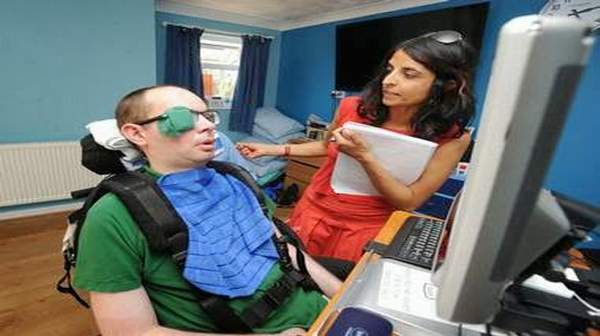Locked-in syndrome can also be due to traumatic brain injury, demyelinating diseases (disorders in which the insulating material around brain cells is lost), and medication overdose.
Diagnosis
Diagnosis is primarily clinical. Because patients lack the motor responses (eg, withdrawal from painful stimuli) usually used to measure responsiveness, they may be mistakenly thought to be unconscious. Thus, all patients who cannot move should have their comprehension tested by requesting eye blinking or vertical eye movements.
As in vegetative state, neuroimaging is indicated to rule out treatable disorders. Brain imaging with CT or MRI is done and helps identify the pontine abnormality. PET, SPECT, or functional MRI may be done to further assess cerebral function if the diagnosis is in doubt. In patients with locked-in syndrome, EEG shows normal sleep-wake patterns.
Treatment
There is no cure for locked-in syndrome, nor is there a standard course of treatment.
Early recognition of LiS state is important for rehabilitation. It is essential that LiS patients play an active role in decision-making processes regarding their rehabilitation. A reliable code to indicate yes and no usually constitutes the basis of communication. Initially many use eye movements and blinking to communicate. Because language skills are usually intact, many employ a system of spelling via an alphabetical code whereby the person with LiS indicates the desired letter by moving their eyes or blinking.
Early on, individuals with LiS need to be equipped with a means to indicate their needs or a desire to communicate. Should the patient regain control of a reliable movement, that could enable the activation of a switch enabling access to communication devices (eg computer with synthetic voice).
Initially, patients are essentially fed through a feeding tube. Following the initial assessment of their swallowing ability, most patients gradually start with eating smooth purees and thickened liquids. Tracheostomy, mechanical ventilation, cardiac failure, chronic obstructive pulmonary disease, uncontrolled emotional lability, improper positioning during feeding, undernutrition or dehydration are factors that may lead the healthcare team to remain cautious regarding feeding through the mouth.
To promote functional use of the patient’s emergent voluntary movements, it can be helpful to progressively move the patient into a more vertical position. Exercises to maintain range of motion, as well as breathing, eyes, head, trunk and limb control exercises are performed throughout the rehabilitation process. Stretching exercises, use of antispasmodic drugs or botulinum toxin injections help to decrease spasticity.
Prognosis
While in rare cases some patients may regain certain functions, the chances for motor recovery are very limited.





